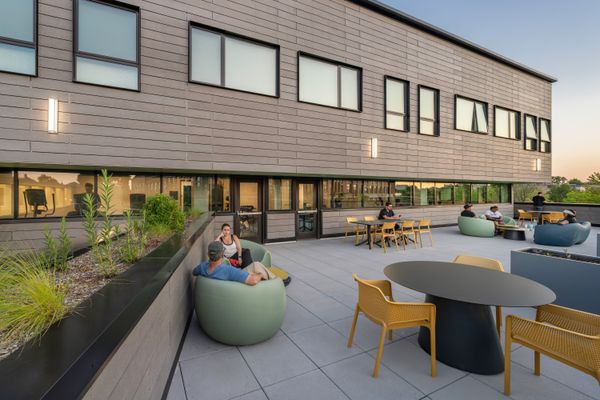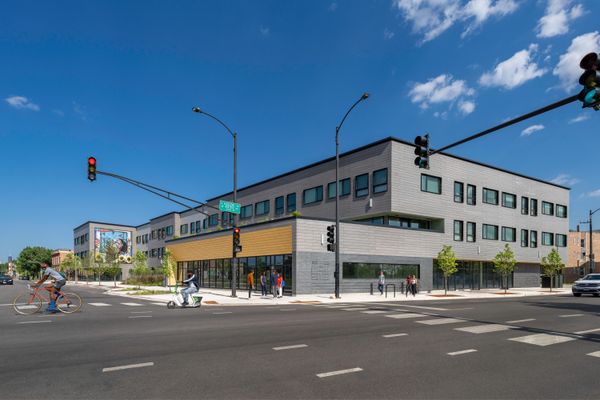In East Garfield Park, architects are using unconventional design, construction methods, and sustainability goals to not just build more housing, but help stabilize a working-class community.
When Dawveed Scully, the managing deputy commissioner at the City of Chicago’s Department of Planning and Development, travels to disinvested neighborhoods to meet with residents and business leaders, he often hears about their needs for retail and small business investment. A lack of grocery stores and basic goods is prevalent, but it’s difficult to attract these types of businesses to areas with demolished buildings and vacant lots. "We hear often from retailers that retail follows rooftops," he says. "They’re always going to look at the population in a specific area, as well as the incomes of that population, especially for national retailers."
To combat depopulation, the city is leveraging nearly 10,000 parcels of city-owned lots. According to the Chicago Community Trust, my neighborhood of East Garfield Park on Chicago’s West Side lost 40 percent of its population between 1980 and 2017. But just a stone’s throw from my front door, city and county-owned vacant land now hosts new housing typologies. Building off the success of their initial Hem House, architects at Future Firm completed a "version 2.0" of their original single-family home; to the west, a new affordable multifamily development by Perkins&Will and developer Preservation of Affordable Housing (POAH) opened this year; and, just north, Inherent Homes has been delivering modular single-family homes by the literal truckload. Each project uses unconventional design, construction methods, and sustainability goals to not just build more housing, but help stabilize a working-class population.
There’s no "one weird trick" to repair decades of out-migration, but as we’ve in the Sun Belt, building housing—and lots of it—drives new growth, jobs, and amenities. The search for affordability remains key to growing a tax base, and vacant lots are often a common tool. We’ve seen design competitions in Los Angeles, New York City, and Chicago, among others, that ask designers to generate ideas for land that is cheap or free. The aforementioned projects in Garfield Park achieved varying degrees of affordability using lots that were either owned by the City of Chicago or the Cook County Land Bank.
"We want to get [vacant lots] filled in, but they also provide an opportunity to think differently about how we’re filling them in," says Scully. "Particularly in the Chicago neighborhoods that were built a hundred years ago, those [homes] were innovative for their time. We are interested in doing things that are also innovative for these times, whether it’s promoting all-electric or integrating more efficient systems into buildings, making construction more efficient and timely and quick, as well."
Future Firm conceived of Hem House as a prototype that reduces construction costs and time by using off-the-shelf materials and a concrete slab foundation. However, keeping land costs down was a must. "One of the strategies to make Hem House less expensive was to use Land Bank land, which is always sold under market value," says Craig Reschke, Future Firm cofounder. "We also looked for places where we thought there could be demand—that were close to transportation, close to downtown—and East Garfield Park seemed like the place that was most ready for new construction."

The interior of Hem House by Future Firm.
Photo: Daniel Kelleghan
The neighborhood was a center for commercial activity up until 1968, when riots following Martin Luther King Jr.’s assassination resulted in arson and later demolition; ProPublica reported that, decades after, "government and private sector neglect" has kept the area languishing. Still, the neighborhood benefits from access to multiple cross-city transit lines, job centers, and freeways that connect Chicago with Western suburbs. When Perkins&Will and POAH won the C40 Reinventing Cities competition in 2019 to design a passive house multifamily building on a series of vacant city-owned lots in the neighborhood, Justin Wortmann, the firm’s residential practice leader, called it "a no brainer."
"[Garfield Park] should be a place of incredible commercial activity and vibrant neighborhoods. But of course, with the disinvestment that we’ve seen over time, that never really materialized," he says.
Their 43-unit mixed-use housing and retail center opened earlier this year and serves those earning between 30 and 80 percent of the Area Median Income (AMI). Not only do residents have access to community terraces and amenity rooms, the passive house standards also mean that utility bills will be negligible. Once the building opened it received 4,000 applications from potential residents, according to Block Club Chicago.

A community terrace at Fifth City Commons, the result of Perkins&Will and developer POAH winning the C40 Reinventing Cities competition in 2019.
Photo by James Steinkamp
As a passive house, affordable multifamily building, it’s unique in an environment where such innovations aren’t as frequently used. But Wortmann believes that the neighborhood’s tremendous need for housing that prioritizes low utility bills, durable materials, and health benefits—such as cleaner indoor air, which can improve asthma management and cardiovascular health—made this building necessary. "These neighborhoods that have borne the brunt of disinvestment shouldn’t also bear the long-term costs of poor building practices and poor building performance," he says. "What the community needs isn’t just a relief from energy prices…these are the [neighborhoods] that are most in crisis from a lack of available, high-quality housing."

The exterior of Fifth City Commons, a passive house multifamily building on a series of vacant city-owned lots.
Photo by James Steinkamp
See the full story on Dwell.com: Chicago Is Experimenting With a Solution to Depopulation: New Housing on City-Owned Land
Related stories:
- "Freedom Cities" Won’t Solve the Housing Crisis
- Sicily Is Getting a €13.5 Billion Bridge—and Everything Else You Need to Know About This Week
- Where Do We Put All Our (Literal) Baggage?
Read More
By: Anjulie Rao
Title: Chicago Is Experimenting with a Solution to Depopulation: New Housing on City-Owned Land
Sourced From: www.dwell.com/article/chicago-is-experimenting-with-a-solution-to-depopulation-new-housing-on-city-owned-land-116ff6c1
Published Date: Mon, 18 Aug 2025 18:08:59 GMT
Did you miss our previous article...
https://trendinginbusiness.business/real-estate/budget-breakdown-with-240k-a-design-duo-returned-their-florida-midcentury-to-its-former-glory
.png)





